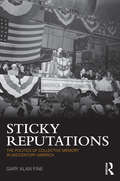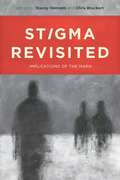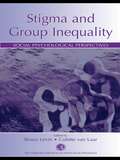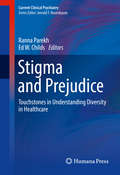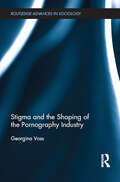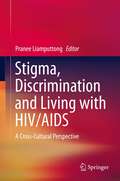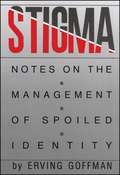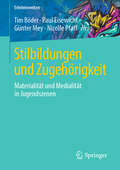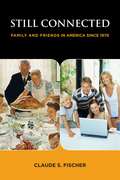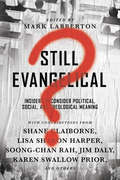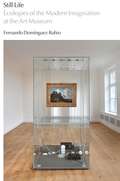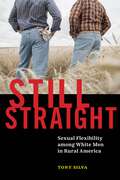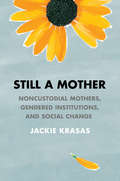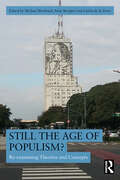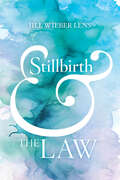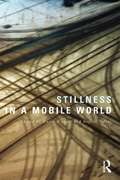- Table View
- List View
Sticky Reputations: The Politics of Collective Memory in Midcentury America
by Gary Alan FineSticky Reputations focuses on reputational entrepreneurs and support groups shaping how we think of important figures, within a crucial period in American history – from the 1930s through the 1950s. Why are certain figures such as Adolf Hitler, Joe McCarthy, and Martin Luther King cemented into history unable to be challenged without reputational cost to the proposer of the alternative perspective? Why are the reputations of other political actors such as Harry Truman highly variable and changeable? Why, in the 1930s, was it widely believed that American Jews were linked to the Communist Party of America but by the 1950s this belief had largely vanished and was not longer a part of legitimate public discourse? This short, accessible book is ideal for use in undergraduate teaching in social movements, collective memory studies, political sociology, sociological social psychology, and other related courses.
Stigma (Psychology Library Editions: Social Psychology)
by Robert M. PageAlthough references to stigma were commonplace in the field of social policy and elsewhere, the concept was often used in a rather imprecise way. Originally published in 1984, this book assesses the relevance of the concept of stigma for the study of social policy. Investigations of the concept within the welfare field have tended to be far too narrow in focus (i.e. the concept has been regarded as a technical problem which can be eradicated by greater adherence to the principle of universalism). As a counter to this perspective, Robert Page argues that it is necessary to distinguish much more clearly between various aspects of the concept of stigma (e.g. stigmas, stigmatization and felt stigma). He examines the reasons why, and the ways in which, one particular ‘welfare’ group – unmarried mothers – have been stigmatized over the centuries in order to highlight the importance of examining existing patterns of ‘welfare’ and other forms of stigmatization within their political, economic, social and historical context. It is concluded that stigma will continue to be a key concept for both students and practitioners within the field of social policy provided that it is examined from this wider perspective.
Stigma Revisited: Implications of the Mark (Alternative Perspectives in Criminology)
by Stacey Hannem & Chris BruckertStigma Revisited: Implications of the Mark is a collection of qualitative, empirical studies of populations who experience stigma. Discrimination, marginality and social injustice are recognized as indelibly tied to the phenomena of stigma. This volume builds on the work of Erving Goffman and integrates a larger, structural understanding of stigma based in Michel Foucault’s governmentality writings. Contemporary notions of risk, riskiness and danger are linked to the labelling of “deviant” populations in the name of social control and risk management; these labels result in the institutional and systemic perpetuation of stereotypes and stigmatic attitudes. The research presented in this book addresses the individual experience of symbolic stigma as well as the collective impact of structural stigma. With unique, personal vignettes that position each of the academic contributors in relation to their subjects, this collection of essays challenges social science researchers to understand their own role in reproducing and contesting hegemonic discourses that stigmatize and marginalize.
Stigma and Group Inequality: Social Psychological Perspectives (Claremont Symposium on Applied Social Psychology Series)
by Shana Levin Colette Van LaarThis book provides a snapshot of the latest theoretical and empirical work on social psychological approaches to stigma and group inequality. It focuses on the perspective of the stigmatized groups and discusses the effects of the stigma on the individual, the interacting partners, the groups to which they belong, and the relations between the groups.Broken into three major sections, Stigma and Group Inequality:*discusses the tradeoffs that stigmatized individuals must contend with as they weigh the benefits derived from a particular response to stigma against the costs associated with it;*explores the ways in which environments can threaten one's intellectual performance, sense of belonging, and self concept; and*argues that the experience of possessing a stigmatized identity is shaped by social interactions with others in the stigmatized group as well as members of other groups.Stigma and Group Inequality is a valuable resource for students and scholars in the fields of psychology, sociology, social work, anthropology, communication, public policy, and political science, particularly for courses on stigma, prejudice, and intergroup relations. The book is also accessible to teachers, administrators, community leaders, and concerned citizens who are trying to understand and improve the plight of stigmatized individuals in school, at work, at home, in the community, and in society at large.
Stigma and Prejudice
by Ranna Parekh Ed W. ChildsIn this innovative title, the authors describe unique patient populations affected by stigma and prejudice and the prevalence of these issues to all healthcare providers. Each chapter covers the forms of prejudice and stigma associated with minority statuses, including religious minorities, the homeless, as well as those stigmatized by medical serious medical conditions, such HIV/AIDS, obesity, and substance misuse disorders. The chapters focus on the importance of recognizing biological differences and similarities within such groups and describes the challenges and best practices for optimum healthcare outcomes. The text describes innovative ways to connect in a clinical setting with people of diverse backgrounds. The text also covers future directions and areas of research and innovative clinical work being done. Written by experts in the field, Stigma and Prejudice is an excellent resource for psychiatrist, psychologists, general physicians, social workers, and all other medical professionals working with stigmatized populations.
Stigma and the Shaping of the Pornography Industry (Routledge Advances in Sociology)
by Georgina VossThe idea of ‘pornography’ is often employed to invoke titillation, anger, and disgust. Stigma and the Shaping of the Pornography Industry explores the effects that this stigmatized identity has on the pornography industry itself. From the video era to the emergence of the internet, to trade shows, white-collar workers, technological innovation, and industry-wide characteristics, this book looks beyond content production to explore how stigma has shaped the structures, practices, norms, and boundaries of the wider sector. By drawing on concepts such as dirty work, core-stigmatized industries, and outlaw innovation, this book offers rich insights into the ways in which stigma is socially constructed and managed, and the deep structural effects that it has on the industry.
Stigma, Discrimination and Living with HIV/AIDS
by Pranee LiamputtongUp until now, many articles have been written to portray stigma and discrimination which occur with people living with HIV/AIDS (PLWHA) in many parts of the world. But this is the first book which attempts to put together results from empirical research relating to stigma, discrimination and living with HIV/AIDS. The focus of this book is on issues relevant to stigma and discrimination which have occurred to individuals and groups in different parts of the globe, as well as how these individuals and groups attempt to deal with HIV/AIDS. The book comprises chapters written by researchers who carry out their projects in different parts of the world and each chapter contains empirical information based on real life situations. This can be used as an evidence for health care providers to implement socially and culturally appropriate services to assist individuals and groups who are living with HIV/AIDS in many societies. The book is of interest to health care providers who have their interests in working with individuals and groups who are living with HIV/AIDS from a cross-cultural perspective. It will be useful for students and lecturers in courses such as anthropology, sociology, social work, nursing, public health and medicine. In particular, it will assist health workers in community health centres and hospitals in understanding issues related to HIV/AIDS and hence provide culturally sensitive health care to people living with HIV/AIDS from different social and cultural backgrounds. The book is useful for anyone who is interested in HIV/AIDS-related stigma and discrimination in diverse social and cultural settings.
Stigma: A Social Psychological Analysis
by I. KatzFirst published in 1982. Routledge is an imprint of Taylor & Francis, an informa company.
Stigma: Notes on the Management of Spoiled Identity
by Erving GoffmanFrom the author of The Presentation of Self in Everyday Life, Stigma is analyzes a person’s feelings about himself and his relationship to people whom society calls “normal.”Stigma is an illuminating excursion into the situation of persons who are unable to conform to standards that society calls normal. Disqualified from full social acceptance, they are stigmatized individuals. Physically deformed people, ex-mental patients, drug addicts, prostitutes, or those ostracized for other reasons must constantly strive to adjust to their precarious social identities. Their image of themselves must daily confront and be affronted by the image which others reflect back to them.Drawing extensively on autobiographies and case studies, sociologist Erving Goffman analyzes the stigmatized person’s feelings about himself and his relationship to “normals” He explores the variety of strategies stigmatized individuals employ to deal with the rejection of others, and the complex sorts of information about themselves they project. In Stigma the interplay of alternatives the stigmatized individual must face every day is brilliantly examined by one of America’s leading social analysts.
Stilbildungen und Zugehörigkeit: Materialität und Medialität in Jugendszenen (Erlebniswelten)
by Nicolle Pfaff Tim Böder Paul Eisewicht Günter MeySzenezugehörigkeiten können als in stilspezifischen Praktiken sozial hervorgebrachte und sinnstiftende Gemeinsamkeiten des Handelns verstanden werden. Sie werden in den jeweiligen Stilbildungen über materielle Artefakte und deren Gebrauch, den Körper sowie mediale Ausdrucksformen angezeigt, inszeniert, stabilisiert und verbreitet. Wenngleich die Bedeutung von Artefakten, Körpern und Medien für Stilisierungsprozesse innerhalb der Jugendkultur- und Szeneforschung kontinuierlich hervorgehoben wird, so rückt die systematische Analyse der materiellen und medialen Dimensionen jugendkulturellen Handelns über die Deskription jeweiliger Stile hinaus nur selten in den Blickpunkt. Von dieser Beobachtung ausgehend soll mit diesem Band der Frage nachgegangen werden, mit welchen theoretischen und methodischen Perspektiven eine interdisziplinäre Jugendkultur- und Szeneforschung die materiellen und medialen Ausdrucksformen von Stilen adäquat verstehen kann. Der Band versammelt Beiträge, die sich der Bedeutung von Materialität und Medialität in Szenen aus historischer, sozial- und kulturwissenschaftlicher sowie psychologischer Perspektive widmen.Der InhaltJugendkulturtheoretische Perspektiven auf Medialität und Materialität • Stilbildungen über Medien • Stilbildungen über Artefakte • Stilbildungen über Körper Die HerausgeberTim Böder ist wissenschaftlicher Mitarbeiter der AG Jugend- und Schulforschung an der Universität Duisburg-Essen.Dr. Paul Eisewicht ist wissenschaftlicher Mitarbeiter am Institut für Soziologie an der Technischen Universität Dortmund.Prof. Dr. Günter Mey lehrt Entwicklungspsychologie und qualitative Forschung an der Hochschule Magdeburg-Stendal.Prof. Dr. Nicolle Pfaff ist Hochschullehrerin an der Fakultät für Bildungswissenschaften an der Universität Duisburg-Essen.
Still Connected: Family and Friends in America Since 1970
by Claude S. FischerNational news reports periodically proclaim that American life is lonelier than ever, and new books on the subject with titles like Bowling Alone generate considerable anxiety about the declining quality of Americans’ social ties. Still Connected challenges such concerns by asking a simple yet significant question: have Americans’ bonds with family and friends changed since the 1970s, and, if so, how? Noted sociologist Claude Fischer examines long-term trends in family ties and friendships and paints an insightful and ultimately reassuring portrait of Americans’ personal relationships. Still Connected analyzes forty years of survey research to address whether and how Americans’ personal ties have changed—their involvement with relatives, the number of friends they have and their contacts with those friends, the amount of practical and emotional support they are able to count on, and how emotionally tied they feel to these relationships. The book shows that Americans today have fewer relatives than they did forty years ago and that formal gatherings have declined over the decades—at least partially as a result of later marriages and more women in the work force. Yet neither the overall quantity of personal relationships nor, more importantly, the quality of those relationships has diminished. Americans’ contact with relatives and friends, as well as their feelings of emotional connectedness, has changed relatively little since the 1970s. Although Americans are marrying later and single people feel lonely, few Americans report being socially isolated and the percentage who do has not really increased. Fischer maintains that this constancy testifies to the value Americans place on family and friends and to their willingness to adapt to changing circumstances in ways that sustain their social connections. For example, children now often have schedules as busy as their parents. Yet today’s parents spend more quality time with their children than parents did forty years ago—although less in the form of organized home activities and more in the form of accompanying them to play dates or sports activities. And those family meals at home that seem to be disappearing? While survey research shows that families dine at home together less often, it also shows that they dine out together more often. Americans are fascinated by the quality of their relationships with family and friends and whether these bonds fray or remain stable over time. With so many voices heralding the demise of personal relationships, it’s no wonder that confusion on this topic abounds. An engrossing and accessible social history, Still Connected brings a much-needed note of clarity to the discussion. Americans’ personal ties, this book assures us, remain strong.
Still Connected: Family and Friends in America since 1970
by Fischer Claude S.National news reports periodically proclaim that American life is lonelier than ever, and new books on the subject with titles like Bowling Alone generate considerable anxiety about the declining quality of Americans' social ties. Still Connected challenges such concerns by asking a simple yet significant question: have Americans' bonds with family and friends changed since the 1970s, and, if so, how? Noted sociologist Claude Fischer examines long-term trends in family ties and friendships and paints an insightful and ultimately reassuring portrait of Americans' personal relationships. Still Connected analyzes forty years of survey research to address whether and how Americans' personal ties have changed--their involvement with relatives, the number of friends they have and their contacts with those friends, the amount of practical and emotional support they are able to count on, and how emotionally tied they feel to these relationships. The book shows that Americans today have fewer relatives than they did forty years ago and that formal gatherings have declined over the decades--at least partially as a result of later marriages and more women in the work force. Yet neither the overall quantity of personal relationships nor, more importantly, the quality of those relationships has diminished. Americans' contact with relatives and friends, as well as their feelings of emotional connectedness, has changed relatively little since the 1970s. Although Americans are marrying later and single people feel lonely, few Americans report being socially isolated and the percentage who do has not really increased. Fischer maintains that this constancy testifies to the value Americans place on family and friends and to their willingness to adapt to changing circumstances in ways that sustain their social connections. For example, children now often have schedules as busy as their parents. Yet today's parents spend more quality time with their children than parents did forty years ago--although less in the form of organized home activities and more in the form of accompanying them to play dates or sports activities. And those family meals at home that seem to be disappearing? While survey research shows that families dine at home together less often, it also shows that they dine out together more often. Americans are fascinated by the quality of their relationships with family and friends and whether these bonds fray or remain stable over time. With so many voices heralding the demise of personal relationships, it's no wonder that confusion on this topic abounds. An engrossing and accessible social history, Still Connected brings a much-needed note of clarity to the discussion. Americans' personal ties, this book assures us, remain strong.
Still Evangelical?: Insiders Reconsider Political, Social, and Theological Meaning
by Shane Claiborne Soong-Chan Rah Karen Swallow Prior Mark Labberton Jim Daly Lisa Sharon Harper Mark Galli Tom Lin Robert Chao Romero Sandra Maria Van Opstal Allen Yeh Mark S. YoungShane Claiborne, Red Letter ChristiansJim Daly, Focus on the FamilyMark Galli, Christianity TodayLisa Sharon Harper, FreedomRoad.usTom Lin, InterVarsity Christian FellowshipKaren Swallow Prior, Liberty UniversitySoong-Chan Rah, North Park UniversityRobert Chao Romero, UCLASandra Maria Van Opstal, Grace and Peace CommunityAllen Yeh, Biola UniversityMark Young, Denver Seminary
Still Fighting the Civil War: The American South and Southern History
by David R. GoldfieldSouthern thought since the Civil War.
Still Hungry in America
by Robert ColesBefore a child is born he has already lived a life; and when he is born he comes into more than the immediate world of his mother's arms. Not all pregnant women can take food and vitamins for granted, or a gynecologist to tell them they are indeed pregnant or an obstetrician to watch them and care for them and eventually deliver them a healthy son or daughter. For that matter, not all pregnant women can take for granted clean, running water, or a home that is warm in winter and reasonably free of germ-bearing flies and mosquitoes in summer. Nor can some pregnant women forget about rats and cockroaches, or garbage that is ignored by local "authorities," or sewage that is not adequately drained away.These are American women, American mothers, American children.
Still Life: Ecologies of the Modern Imagination at the Art Museum
by Fernando Domínguez RubioHow do you keep the cracks in Starry Night from spreading? How do you prevent artworks made of hugs or candies from disappearing? How do you render a fading photograph eternal—or should you attempt it at all? These are some of the questions that conservators, curators, registrars, and exhibition designers dealing with contemporary art face on a daily basis. In Still Life, Fernando Domínguez Rubio delves into one of the most important museums of the world, the Museum of Modern Art (MoMA) in New York, to explore the day-to-day dilemmas that museum workers face when the immortal artworks that we see in the exhibition room reveal themselves to be slowly unfolding disasters. Still Life offers a fascinating and detailed ethnographic account of what it takes to prevent these disasters from happening. Going behind the scenes at MoMA, Domínguez Rubio provides a rare view of the vast technological apparatus—from climatic infrastructures and storage facilities, to conservation labs and machine rooms—and teams of workers—from conservators and engineers to guards and couriers—who fight to hold artworks still. As MoMA reopens after a massive expansion and rearranging of its space and collections, Still Life not only offers a much-needed account of the spaces, actors, and forms of labor traditionally left out of the main narratives of art, but it also offers a timely meditation on how far we, as a society, are willing to go to keep the things we value from disappearing into oblivion.
Still Life: Ecologies of the Modern Imagination at the Art Museum
by Fernando Domínguez RubioHow do you keep the cracks in Starry Night from spreading? How do you prevent artworks made of hugs or candies from disappearing? How do you render a fading photograph eternal—or should you attempt it at all? These are some of the questions that conservators, curators, registrars, and exhibition designers dealing with contemporary art face on a daily basis. In Still Life, Fernando Domínguez Rubio delves into one of the most important museums of the world, the Museum of Modern Art (MoMA) in New York, to explore the day-to-day dilemmas that museum workers face when the immortal artworks that we see in the exhibition room reveal themselves to be slowly unfolding disasters. Still Life offers a fascinating and detailed ethnographic account of what it takes to prevent these disasters from happening. Going behind the scenes at MoMA, Domínguez Rubio provides a rare view of the vast technological apparatus—from climatic infrastructures and storage facilities, to conservation labs and machine rooms—and teams of workers—from conservators and engineers to guards and couriers—who fight to hold artworks still. As MoMA reopens after a massive expansion and rearranging of its space and collections, Still Life not only offers a much-needed account of the spaces, actors, and forms of labor traditionally left out of the main narratives of art, but it also offers a timely meditation on how far we, as a society, are willing to go to keep the things we value from disappearing into oblivion.
Still Life: Ecologies of the Modern Imagination at the Art Museum
by Fernando Domínguez RubioHow do you keep the cracks in Starry Night from spreading? How do you prevent artworks made of hugs or candies from disappearing? How do you render a fading photograph eternal—or should you attempt it at all? These are some of the questions that conservators, curators, registrars, and exhibition designers dealing with contemporary art face on a daily basis. In Still Life, Fernando Domínguez Rubio delves into one of the most important museums of the world, the Museum of Modern Art (MoMA) in New York, to explore the day-to-day dilemmas that museum workers face when the immortal artworks that we see in the exhibition room reveal themselves to be slowly unfolding disasters. Still Life offers a fascinating and detailed ethnographic account of what it takes to prevent these disasters from happening. Going behind the scenes at MoMA, Domínguez Rubio provides a rare view of the vast technological apparatus—from climatic infrastructures and storage facilities, to conservation labs and machine rooms—and teams of workers—from conservators and engineers to guards and couriers—who fight to hold artworks still. As MoMA reopens after a massive expansion and rearranging of its space and collections, Still Life not only offers a much-needed account of the spaces, actors, and forms of labor traditionally left out of the main narratives of art, but it also offers a timely meditation on how far we, as a society, are willing to go to keep the things we value from disappearing into oblivion.
Still Moving Field Guide: Change Vitality At Your Fingertips
by Deborah RowlandThe companion to the bestselling book on leading change, Still Moving Still Moving Field Guide is a companion to the bestselling Still Moving: How to Lead Mindful Change. Designed as a practical resource, the Field Guide takes the reader on a journey to hone their leadership skills in order to lead change with confidence. Step by step, readers will progress through the Still Moving concepts. New to the guide is the innovative Change Vitality model (an energizing holistic way of leading change) that puts all the Still Moving concepts into one effective picture. The author breaks down each element of the Change Vitality model and explores what the element is, how to recognize it, and why it helps leaders lead change well. The model also shows how to rate your own leadership in a particular skill, and includes tales from the field on putting the skill into action. The guide also contains further reading and resources to help cultivate the skills presented. This important book: Offers a practical guide for developing the change leadership skills outlined in Still Moving Contains application stories with real life leaders in change Presents the Change Vitality model - a new, holistic and research-based framework for how to lead change with greater ease Provides an interactive immersion journey into the Still Moving content Includes spaces for journaling and self-reflection Written for all curious change leaders, change coaches, change consultants, and HR professionals, the Still Moving Field Guide is filled with practical ideas on how to use the Still Moving concepts with yourself, your team, and the wider systems you are seeking to transform.
Still Moving: How to Lead Mindful Change
by Deborah RowlandStill Moving: How to Lead Mindful Change sets out an innovative approach for guiding organisations and indeed entire systems through ongoing, disruptive change. It combines Deborah Rowland's own rigorous research into change and its leadership with insights from her extensive field experience helping major global corporations including GlaxoSmithKline, RWE and Shell achieve lasting change with increased productivity, employee engagement and responsible societal impact. It is filled with helpful inspiring stories of leadership and change from the real world and, bravely, the author's own personal journey. Challenging leaders to cultivate both their inner and outer skills necessary for success, Still Moving weaves together the "being" and "doing" of states of leading change and emphasises the importance of a mindful stance and deep systemic perception within a leader. With the goal of collaborative, sustainable change, the book delves into a variety of important topics, including present-moment awareness, intentional response, edge and tension and emergent change. Compelling and provocative, Still Moving questions the conventional wisdom of much change theory and asks that leaders first work on their inner source in order to more effortlessly change the world around them.
Still Straight: Sexual Flexibility among White Men in Rural America
by Tony SilvaWhy some straight men have sex with other menWhy do some straight men in rural America have sex with other men? In Still Straight, Tony Silva convincingly argues that these men—many of whom enjoy hunting, fishing, and shooting guns—are not gay, bisexual, or “just experimenting.” As he shows, these men can enjoy a range of relationships with other men, from hookups to sexual friendships to secretive loving partnerships, all while strongly identifying with straight culture.Drawing on riveting interviews with straight white men who live in rural America, Silva explores the fascinating, and unexpected, disconnect between sexual behavior and identity. Some use sex with men to bond with other men in an acceptably masculine way; some are not particularly attracted to men, but are wary of emotional attachment with women; and others view sex with men—as opposed to women—as a more acceptable form of extramarital sexual behavior.Taking us inside the lives of straight white men who have sex with other men, Still Straight shows us that heterosexuality in rural America is not always, in fact, what it seems.
Still a Mother: Noncustodial Mothers, Gendered Institutions, and Social Change
by Jackie KrasasJackie Krasas traces the trajectories of mothers who have lost or ceded custody to an ex-partner. She argues that these noncustodial mothers' experiences should be understood within a greater web of gendered social institutions such as employment, education, health care, and legal systems that shapes the meanings of contemporary motherhood in the United States. If motherhood means "being there," then noncustodial mothers, through their absence, are seen as nonmothers. They are anti-mothers to be reviled. At the very least, these mothers serve as cautionary tales.Still a Mother questions the existence of an objective method for determining custody of children and challenges the "best-interests standard" through a feminist, reproductive justice lens. The stories of noncustodial mothers that Krasas relates shed light on marriage and divorce, caregiving, gender violence, and family court. Unfortunately, much of the contemporary discussion of child custody determination is dominated either by gender-neutral discussions, or, at the opposite end of the spectrum, by the idea that fathers are severely disadvantaged in custody disputes. As a result, the idea that mothers always receive custody has taken on the status of common sense. If this was true, as Krasas affirms, there would be no book to write.
Still the Age of Populism?: Re-examining Theories and Concepts
by Michael Bernhard Amie Kreppel de la Torre, CarlosStill the Age of Populism? investigates current conceptions of populism and its relevance across the globe. Using contextualized case studies, cross-national comparisons, and theoretical interventions, this volume addresses key conceptual debates in comparative politics and political sociology.This essential volume brings together scholars from different traditions in political sociology, political science and cultural studies, and comparativists and area experts working on Latin America, Western and Eastern Europe, and the US. Chapters in the book employ innovative theoretical approaches to study aspects of populism in global comparative perspective whilst regional case studies, including Brazil, Venezuela, Germany, and the US, are utilised to explore populism in geographically specific contexts. In doing so, the volume addresses the key issues for those seeking to understand contemporary populism. What are the advantages and limits of the category of populism to understand contemporary debates on democratization and processes of democratic erosion? Under what structural, institutional, and cultural conditions does populism emerge? Is populism the nemesis of democracy, its shadow, or a path to move beyond “liberal democracy” towards “real democracy”? What lessons does the history of past populist moment hold for our understanding of contemporary populist governance? Under what conditions have populists in office led to political polarization and democratic erosion? What comes after populism, and how do societies deal with its legacies?Still the Age of Populism? will be of interest to a broad audience of students and scholars of political sociology and comparative politics.
Stillbirth and the Law
by Jill Wieber LensEach year in the United States, about 1 in 170 births is a stillbirth, a rate that has remained stagnant for most of this century even as other high-income countries have dramatically reduced their already lower rates. Jill Wieber Lens, the nation’s foremost expert on stillbirth and the law, blends personal experience and legal analysis to bring us an original, essential guide to this all-too-often unrecognized public health crisis. By exposing how the law inhibits prevention, affects the experience of stillbirth for birthing parents, and shapes broader notions of unborn life, Lens argues for a series of pragmatic, data-driven changes to the legal landscape that could enjoy broad popular support and strengthen reproductive justice and reproductive rights.
Stillness in a Mobile World (International Library of Sociology)
by David Bissell Gillian FullerThis edited collection of essays on the conceptual, political and philosophical importance of stillness is positioned within a world that has increasingly come to be understood through the theoretical and conceptual lens of movement. With contributions from leading scholars in the field, the diversity of this collection illuminates the multiplicity of ontological and epistemological registers through which stillness moves: from human geography to media studies, cultural theory to fine arts. With the help of luminaries such as Deleuze, Bergson, Barthes and Beckett, this book interweaves cutting-edge theoretical insight with empirical illustrations which examine and traverse a multitude of practices, spaces and events. In an era where stasis, slowness and passivity are often held to be detrimental, this collection puts forward a new set of political and ethical concerns which help us to come to terms with, understand, and account for (im)mobile life. Stillness in a Mobile World in an essential source of reference for both undergraduate and post-graduate students working within disciplines such as cultural studies, sociology, mobility studies, and human geography.
